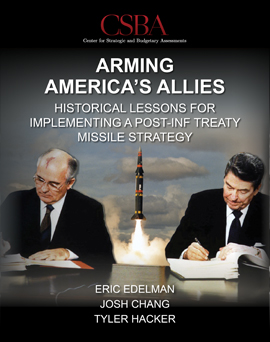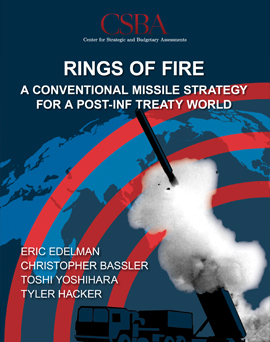CSBA hosted a webinar discussion on CSBA’s latest publications, Arming America’s Allies, by Eric Edelman, Josh Chang, and Tyler Hacker; and Rings of Fire, by Eric Edelman, Chris Bassler, Toshi Yoshihara, and Tyler Hacker. We were delighted to have Congressman Mike Gallagher, the representative of Wisconsin’s 8th Congressional District, as a guest commenter on the monographs. Rep. Gallagher was a United States Marine Corps intelligence officer and has a Ph.D. in government and international relations along with deep expertise in the topics addressed in the two studies.
Arming America’s Allies and Rings of Fire
In the aftermath of the U.S. withdrawal from the Intermediate-Range Nuclear Forces (INF) Treaty in 2019, then-Secretary of Defense Mark Esper indicated that he believed it would be useful to deploy conventional intermediate-range ballistic missiles in the Indo-Pacific region. But it is not yet clear that allied or partner governments in either this region or in Europe would be willing to host such capabilities on their territory. In addition, the United States has tested and fielded a variety of systems that could bolster its long-range strike capabilities but lacks a clear path for how the various service initiatives might contribute collectively to a broader precision-strike complex.
 In Arming America's Allies: Historical Lessons for Implementing a Post-INF Treaty Missile Strategy, Eric Edelman, Josh Chang, and Tyler Hacker revisit episodes from the Cold War, including the Korean War and Euromissile Crisis, to posit what role INF missiles could play in U.S. alliances and partnerships in this new era in both Europe and the Indo-Pacific. Although NATO's relationship with "the nuclear umbrella" is commonly discussed, the authors note that it "was not born a nuclear alliance but became one in the wake of multiple strategic shocks." The story is similar for the United States in the Indo-Pacific; the Korean War, the 1958 Taiwan crisis, and decolonization in Indochina all rapidly affected the strategic landscape. Nor were these nuclear agreements free of complexities both domestically and abroad. The authors conclude that the controversies surrounding missile deployments abroad during the Cold War closely resemble the controversies of today and offer relevant lessons as the United States develops a new conventional deterrence posture.
In Arming America's Allies: Historical Lessons for Implementing a Post-INF Treaty Missile Strategy, Eric Edelman, Josh Chang, and Tyler Hacker revisit episodes from the Cold War, including the Korean War and Euromissile Crisis, to posit what role INF missiles could play in U.S. alliances and partnerships in this new era in both Europe and the Indo-Pacific. Although NATO's relationship with "the nuclear umbrella" is commonly discussed, the authors note that it "was not born a nuclear alliance but became one in the wake of multiple strategic shocks." The story is similar for the United States in the Indo-Pacific; the Korean War, the 1958 Taiwan crisis, and decolonization in Indochina all rapidly affected the strategic landscape. Nor were these nuclear agreements free of complexities both domestically and abroad. The authors conclude that the controversies surrounding missile deployments abroad during the Cold War closely resemble the controversies of today and offer relevant lessons as the United States develops a new conventional deterrence posture.
 In Rings of Fire: A Conventional Missile Strategy for a Post-INF Treaty World, Eric Edelman, Chris Bassler, Toshi Yoshihara, and Tyler Hacker discuss how the United States will incorporate intermediate-range conventional missiles into its deterrence posture and which allies and partners could be closely linked to this strategy. The authors propose an analytical framework based on the different ranges of U.S. and adversary missile capabilities, the geostrategic landscape, and the asymmetries in platforms and geography. Rings of Fire then compares the current array of U.S. and allied assets in both regions with proposed capabilities to formulate the building blocks of a new missile strategy. The study concludes with an examination of multiple independent reentry vehicles (MIRVs) and maneuverable reentry vehicles (MARVs) within a conventional missile strategy and their respective utility in both theaters.
In Rings of Fire: A Conventional Missile Strategy for a Post-INF Treaty World, Eric Edelman, Chris Bassler, Toshi Yoshihara, and Tyler Hacker discuss how the United States will incorporate intermediate-range conventional missiles into its deterrence posture and which allies and partners could be closely linked to this strategy. The authors propose an analytical framework based on the different ranges of U.S. and adversary missile capabilities, the geostrategic landscape, and the asymmetries in platforms and geography. Rings of Fire then compares the current array of U.S. and allied assets in both regions with proposed capabilities to formulate the building blocks of a new missile strategy. The study concludes with an examination of multiple independent reentry vehicles (MIRVs) and maneuverable reentry vehicles (MARVs) within a conventional missile strategy and their respective utility in both theaters.



























